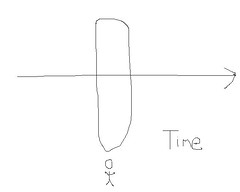Thinking about local history (revised)
-------
The outline below is revised. The presentation was last night.
-------
Tonight I am speaking at an assessment session of the Community Heritage Project of the DC Humanities Council. One of the things that concerns me about local history projects is what I call history as self-affirmation versus putting people and history in context. Too often, people get overfocused on their moment in time rather than the continuum of time.... and maybe I am too focused on the continuum, and interpreting the systems and structures and processes of history and urbanology, rather than the people. Still, linking the micro to the macro is important. And sometimes this is best done by layering concepts from urban sociology over urban history.
Below is the outline. Forgive the drawing...

Individual people at their moment and the continuum of history.
1. Are we part of history? Historic preservation: buildings constructed and used by great (usually white) men vs. recognizing the nexus of architecture, place, and (social, cultural, and economic) history. Public history. Our "responsibilities" as stewards. Veracity. Howard Zinn, People's History of the United States.
Issues of history as community building, self-affirmation, versus broader questions.
2. Time. One moment vs. the continuum.
3. Multiple perspectives/narratives/stories. Different "demo-" and "psychosocial- graphics. A linear, but a messy line. Mosaic.
Typeset and well-illustrated history textbooks can seemingly polish up history and clean up the messiness.
4. Context: neighborhood, city, regional/state, nation, world.
Do this through the creation of historical timelines at different spatial scales, linking local places to global history. (Micro, macro)
For example, unrest-civil war in Central America and Ethiopia/Eritrea in the 1970s and 1980s led to population outmigration from those countries. A great many of these immigrants relocated to Adams-Morgan/Columbia Heights/Mt. Pleasant, impacting those communities in many ways from that point forward. (From the development of local businesses--restaurants and bodegas, to the kinds of products sold in places, to the creation of media--Spanish language newspapers, radio, and television--and the creation of local institutions and services.) A non-DC example is post-war Vietnamese immigration to Northern Virginia, first centered around Clarendon, and now farther out in Fairfax County.
Agency (people) vs. institutions and structures (rules and resources) vs. structuration (people and institutions). (See this.)
Using Invasion-succession theory and the life cycle theory of neighborhood change (human ecology school of sociology) is another way to structure stories of places.
5. Stories + context yields themes.
E.g., Brookland: Maryland colonial history; agriculture and the frontier; freedom of religion vs. state religion and the development of the first amendment--"Queens Chapel Road" and the separation of church and state; rural DC, agriculture and slavery; Civil War and the postwar impact (intra-city urbanization); transportation and mobility (railroads, streetcars, automobiles, subway); Catholic University, Catholicism, and Little Rome; protest and organizing (segregation, freeways, "development").
City themes: 1950s and forward--Civil rights; outmigration; riots/rebellion/civil disturbances; suburbanization of the region; Home Rule.
Linking transportation history and development history: Brookland is a trolley suburb.
Architecture: the neighborhood is dominated by frame, some brick, mostly detached housing. Most construction took place from 1890s-1920s (primary era of significance). Bungalows, Four Square. International Style and African-American architects (1950s). Commercial district constructed during the art moderne period (Newton Theater most prominent example), neon.
6. Competition for awareness and interest in local history.
a. DC's local history is overwhelmed by the fact that the entire world defines Washington, DC around the national story of the United States and the federal government. This creates a market development problem of major proportions. Others define the "local story" in terms of the national narrative of the federal government and the history of the United States as a nation.
-- Teenarama, Deanwood, Cabin John, streetcars (etc.) vs. the Smithsonian Institutions, White House, U.S. Capitol, Washington Monument, and Georgetown and Alexandria for fun.
(When people visit they go to the latter, packing it all in a short time, leaving little time to see places that aren't part of the "National Experience" narrative.)
b. People's expectations and the competition
-- World of Coke (Atlanta), Disneyland, Madame Tussaud's Wax Museum (opening soon) vs. (Smithsonian) museums vs. Sumner School Archives vs. places in neighborhoods.
7. How can and how do we tell the stories? (Codification and display) Stilgoe's Outside Lies Magic.
a. Target message and medium by audience (age, other criteria)
b. Material/method/place. Material -- written, aural, visual. Material -- published, online.
-- books/Images of America series
-- history trail signage
-- historic district brochures
-- "Flashbacks" by Patrick Reynolds, newspapers, radio, television
-- video
-- building and place markers
-- collections (Washingtoniana, HSW-Kiplinger Library, Sumner, GWU Gelman Library Special Collections, Moorland-Spingarn, other University archives, i.e., Catholic University, Gallaudet)
-- libraries and schools as opportunities
-- K-12 education (examples: Pittsburgh History and Landmarks Foundation, curricula)
-- how history is taught to 4th and 5th graders in Old Havana, Cuba
-- Internet (Cultural Tourism DC, Humanities Council, HSW, DC Public Library, HPO, DC Preservation League, neighborhood organizations and institutions)
-- Multimedia aspects of the Internet (podcasts, sound, video)
-- Cellular phones as information delivery modes
c. How do people consume the story within places (mobility modes) -- walking, bicycling, driving, online -- and how do we deliver the information to them to meet the requirements of the mode?
d. Languages other than English
8. How do we organize, plan, and fund the provision and management of cultural resources?
-- rebalancing the tourism tax revenue stream (hotel, restaurant, and rental car taxes) to fund cultural resources and projects more significantly
9. Leveraging the resources of the network of organizations providing bits and pieces of these services, information development, capacity building, training.
Labels: cultural heritage/tourism, historic preservation, local history, tourism, urban history



0 Comments:
Post a Comment
<< Home